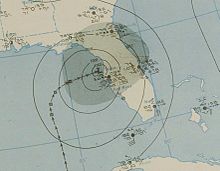 Surface weather analysis of the hurricane on June 24 | |
| Meteorological history | |
|---|---|
| Formed | June 20, 1945 |
| Extratropical | June 27 |
| Dissipated | July 4, 1945 |
| Category 2 hurricane | |
| 1-minute sustained (SSHWS/NWS) | |
| Highest winds | 100 mph (155 km/h) |
| Lowest pressure | <985 mbar (hPa); <29.09 inHg |
| Overall effects | |
| Fatalities | 1 |
| Damage | $75,000 (1945 USD) |
| Areas affected | Big Bend (Florida), Georgia and South Carolina, Outer Banks (North Carolina) |
| IBTrACS | |
Part of the 1945 Atlantic hurricane season | |
The 1945 Outer Banks hurricane was a moderate hurricane that struck Florida and affected the East Coast of the United States in late June, 1945. The first tropical storm and the first hurricane of the Atlantic season, it developed on June 20 in the western Caribbean Sea off Honduras. For the next two days, it moved generally northward into the Gulf of Mexico. Reaching hurricane intensity on June 23, it then turned northeast toward the Florida peninsula. It made landfall in the Big Bend on June 24, then weakened to a tropical storm over land. Minor damage was reported in Florida, but the storm produced heavy, though beneficial, rains that eased one of the state's worst recorded droughts. Upon entering the Atlantic Ocean, it re-intensified into a hurricane and paralleled the East Coast. On June 26, it struck the Outer Banks of North Carolina as a minimal hurricane, producing minor damage but heavy rainfall.
Continuing northeast, the cyclone delivered gale-force winds to New York and southern New England, causing traffic accidents and minor wind damage. Heavy rains drenched the area, and high waves offshore caused ships to need rescue. One man died in a traffic accident; some people were rescued on Long Island Sound. Peak winds on land were 66 miles per hour (106 km/h) at Nantucket, forcing ships to remain in port. The U.S. Coast Guard sought to escort ships at sea into safe harbor. Overall, the impact of the storm was minor, though temperatures fell almost 20 °F (−7 °C) the day after the storm.